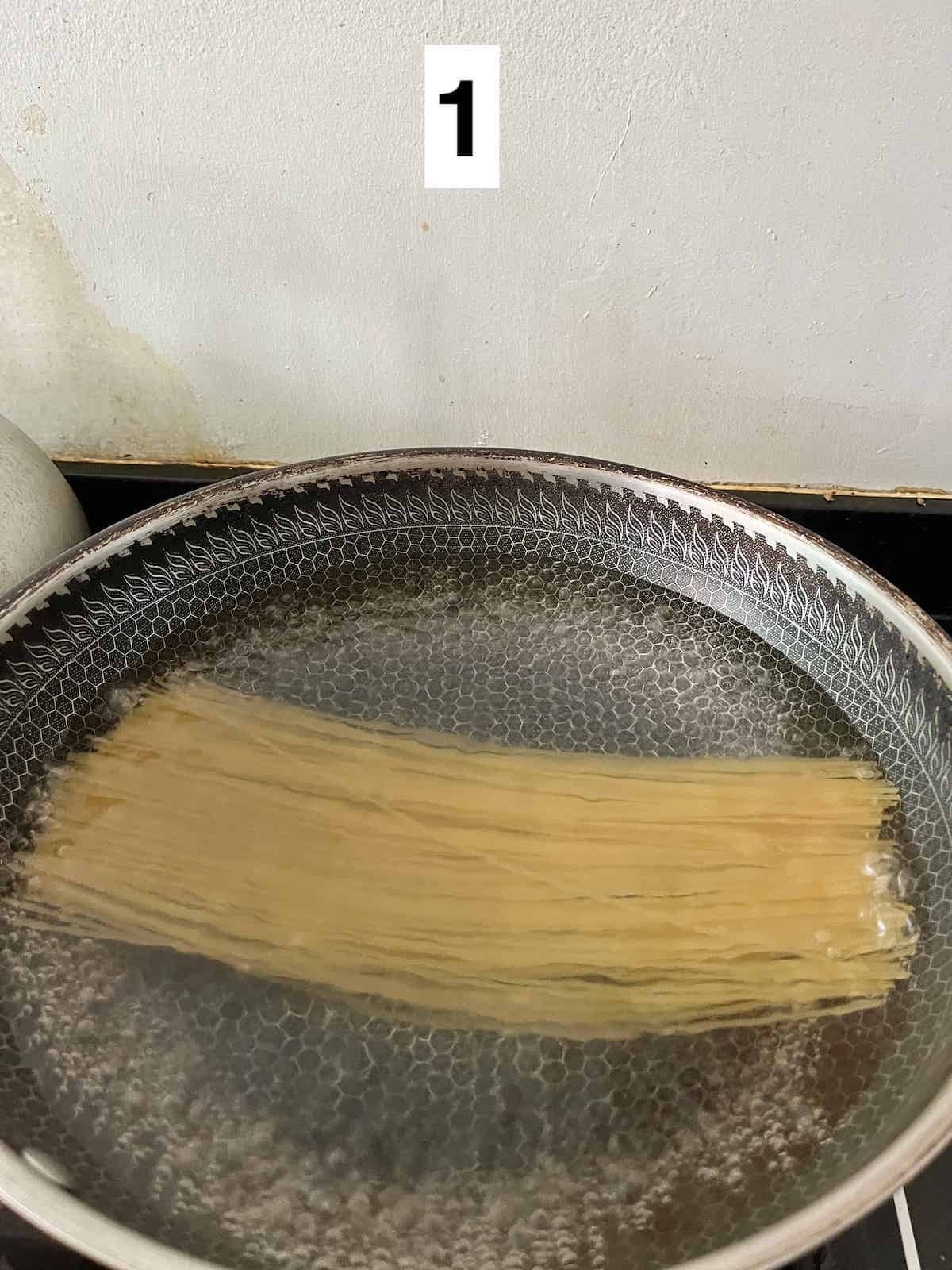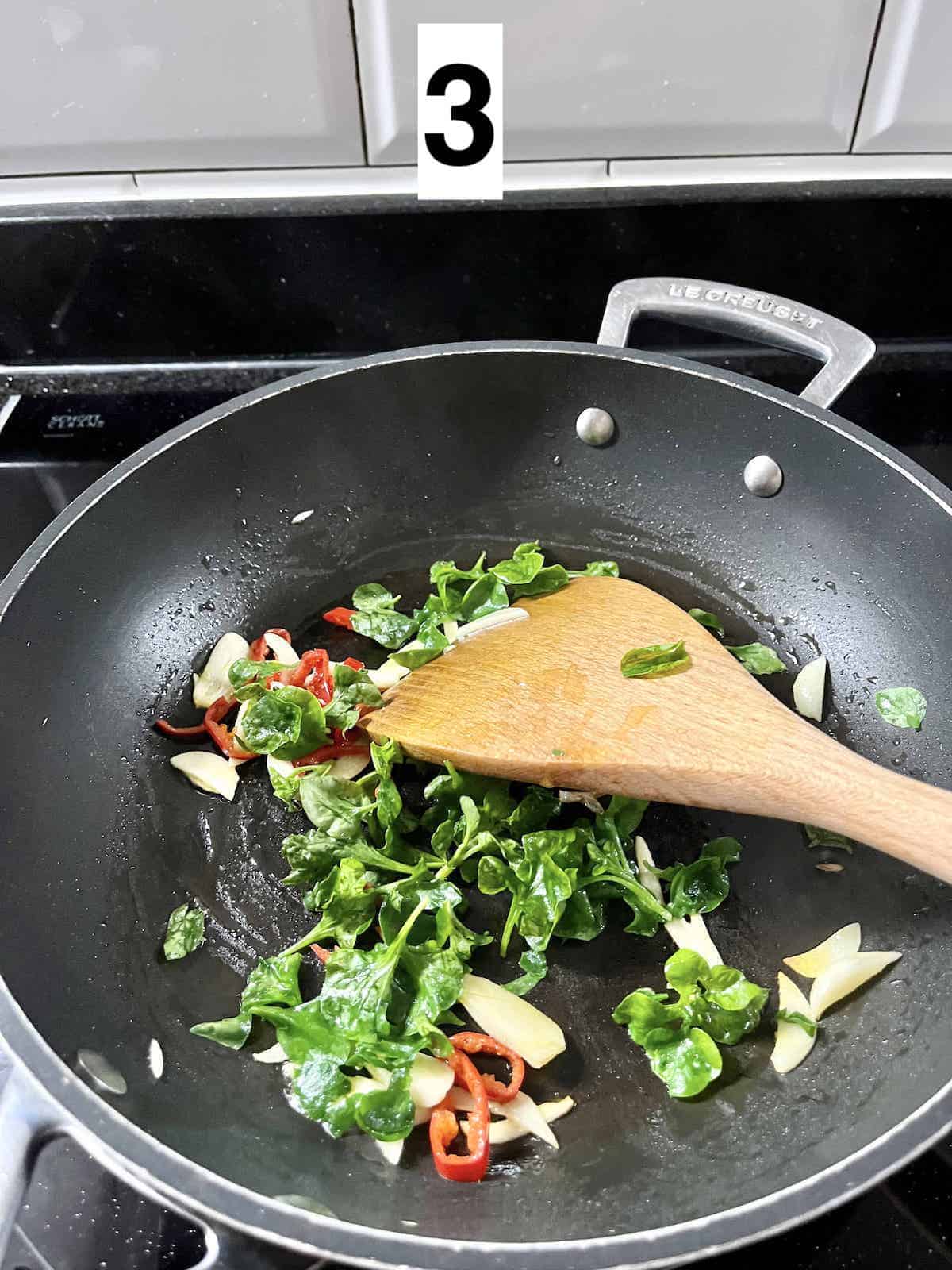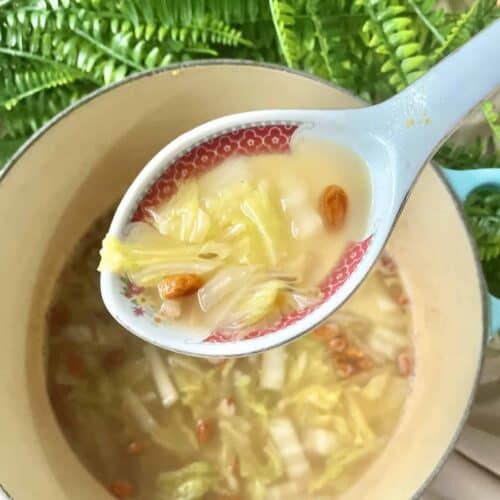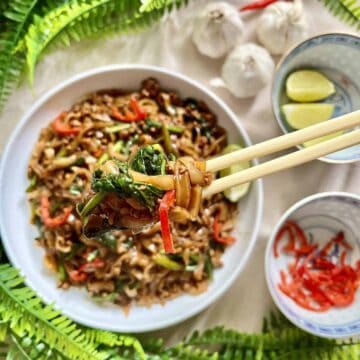This easy Drunken Noodles recipe, also known as Drunkard Noodles recipe (Pad Kee Mao), uses readily available ingredients, such as spaghetti and canned tuna, but also shares the steps and ingredients to make an authentic version. It's a deliciously quick weeknight dinner, on the dinner table in 20 minutes! (Despite the name, there is no alcohol in the recipe- the spicy noodles do taste amazing with a cold beer though!)

Jump to:
⭐ Why This Recipe is a Star
- Easy and delicious: Thai Drunken Noodles ผัดขี้เมา (literally translated as "Drunken Stir Fry") is so easy and tasty, my family used to make this- and Thai Basil Fried Rice with Shrimp- every week when we lived in Thailand. (I actually prefer it to Pad Thai.) Although it only requires simple ingredients, some can be hard to get outside of Asia, so I've made the substitutions where necessary. (The authentic ingredient is also mentioned for those with access- you can find the full authentic Pad Kee Mao recipe here.)
- Quick: takes about 20 minutes to cook. Even less if you use angel hair pasta or glass noodles! (Click through to find out more about the differences between the 2.) Faster and better than takeout!
- Flexible: I use canned tuna because it's fast and cheap. However, you can also substitute canned tuna with your choice of protein, such as leftover chicken roast meat (just make sure it has a neutral flavor) or shrimp. This recipe is so adaptable, I've even seen versions with Shaoxing wine!
Note: if you're vegan, try this Thai basil fried rice instead.
What are Drunken Noodles?
This Thai dish is thought to have originated from a stir-fried dish sans noodles.
Kee Mao translates as Drunkard, but there is no alcohol in the sauce. Rather, the name is said to be because the sweet, salty and savory sauce is supposedly so spicy, it'll wake drunks up (and cure their hangovers.) (I've toned down the spice but you can easily increase the chilies used.)
🥘 Ingredients

The basic ingredients for this Pad Kee Mao recipe are:
- spaghetti: Traditionally, kuaitiao sen yai, or thick and broad rice noodles are used. As you usually need to go to the Asian supermarket for those, I've switched it out for spaghetti pasta instead. Equally good!
- Fresh garlic: this is usually pounded into a paste, along with red chilies and grachai (fingerroot.) Since using a pestle and mortar is more time-consuming, we're just going to stir-fry the garlic and chilies instead. Either slice it or smash it with the back of your knife.(Add the fingerroot if you can get it but, if not, just omit it like I do.) It still tastes great. However, if you can spare the 5 extra minutes, using pounded chili-garlic will take the Spaghetti Pad Kee Mao from good to great! (Do not replace with garlic powder.)
- Fresh red chilies: Thai chili (small potent chilies) is traditional but not everyone can take the heat of mouse shit chilies- literal translation of the Thai name, prik kee noo suan!- so I recommend large red chilies instead. (They're milder. You can also click through for more bird's eye chili substitutes.) You can use red spur chili or red chili paste- do not use paprika powder or chili powder! Don't touch your eyes after handling chilies or you may burn yourself. If you add more chilies to make the dish spicier, you may need to adjust the seasoning and use more sugar and sauce, to balance out the taste.
- hai Thai Basil: Holy Basil is traditional and the 2 Thai herbs are not really interchangeable. However, even in Asia, I find it hard to find a fragrant Thai Holy Basil, so I've subbed out for Thai Basil. Either can do (but don't use Italian Basil/ Sweet Basil!) If, like me, you have problems getting or growing herbs, I HIGHLY recommend the 3-step, Click and Grow indoor gardening set. It's cured my black thumb- and my dark-as-a-tomb apartment- and now I have a bountiful supply of fresh herbs, including Holy Basil, on hand whenever I cook! (For a review of the indoor gardening set, click here.)
- Oyster Sauce: Use Thai brands for the sauces, if you want the most authentic flavor (as different brands of oyster sauce have different formulations.)
- Fish Sauce: if vegan, substitute with light soy sauce (but the flavor will be less authentic.) If not using canned tuna (see below), you may want to add ½ teaspoon or so of light soy sauce.
- Black Soy Sauce: you can get this at the Asian market. Substitute with dark soy sauce or sweet soy sauce.
- Sugar: use palm sugar if you have time to go to Asian grocery store. If not, white sugar or brown sugar will do too.
- Water or unseasoned chicken stock: this is in case the noodles feel too dry when stir-frying. If using seasoned chicken stock, you may need to reduce the amount of fish sauce added.
To make the spicy Thai noodles healthier, add:
- vegetables: this can be anything from Chinese broccoli, bok choy, red bell pepper, baby corn, or Brazilian spinach. If you plan to add more vegetables, you may want to increase the sauce. I suggest adding 2 Tablespoons of light soy sauce, 1 Tablespoon of oyster sauce, 2 teaspoons of dark soy sauce and 1 teaspoon of fish sauce, for every 3 Cups of cut vegetables.
- protein: as mentioned, I use canned tuna but tofu, poached seafood or stir-fried beef work too. You may need to add some light soy sauce in this case (as canned tuna is pretty salty so less seasoning is added.)
Note: I highly recommend a squeeze of fresh lime juice as it'll take the flavor to another level. If you can't get it, add ½ to 1 of teaspoon of rice vinegar or tamarind water when cooking.
Variations
Omit the noodles and just stir-fry the protein and vegetables, then serve with rice and a fried egg. You may need to adjust the amount of sauce added.
🔪 Step-by-Step Instructions

1a. Cook the pasta or soak the dried rice sticks, as per the directions on the packaging. (Once cooked, drain. I don't recommend reserving the pasta water as it will make the dish much too salty.)

2a. Mix the oyster sauce, fish sauce and black soy sauce.
2b. Heat a large skillet or wok over medium-high or high heat. Once the oil is shimmering (but don't let it get so hot that it smokes), add the sliced garlic and chilies.

3. Stir-fry till fragrant for 1-2 minutes, then add the vegetables, stir-frying till cooked.

4. Add the tuna and fry till all warmed up. Use the spatula to break up any clumps.
If substitute with:
- other cooked protein (e.g. shrimp): add it after the noodles to prevent overcooking.
- raw protein (e.g. marinated chicken thighs): stir-fry it now in place of the tuna till cooked. (It will increase the cooking time slightly.)

5. Add the noodles followed by the savory sauce, stirring quickly.
If the noodles feel dry- I'm pretty sure they will because most of us don't stir-fry quickly enough- add some water or unseasoned chicken stock to loosen things up.

6. Add the Thai basil or holy basil, quickly stir, then switch off the fire and plate. (We just want to wilt the fresh basil, not to overcook it!)
Expert Tip: Add a few fresh Thai basil leaves (or holy basil leaves) to the plate of spicy Thai noodles after plating. The different shades of green will make the dish look more attractive. Alternatively, garnish with a lime wedge, coriander leaves, sliced green onion, fried garlic or fried shallots.
🥡 How to Store
Store in an airtight container in the fridge for 2-3 days.
Reheat thoroughly in a pan or microwave. (You will need to add 1-3 Tablespoons of water or unseasoned chicken or vegetable stock to prevent the noodles from drying out.)
💭 Expert Tips
Tip #1: To save time, use fresh rice noodles. You will use about 1.5-2 times the quantity, if switching to fresh noodles. (Fresh noodles cook up more quickly than dried rice noodles or spaghetti but they're harder to find. If your Asian grocer stocks them, they'll be in the refrigerated produce section.) Give them a quick rinse if they appear sticky to the touch.
Tip #2: To make the Pad Kee Mao gluten-free, use wide and flat rice noodles, GF tamari and GF oyster sauce.
Tip #3: If using dried rice noodles for this Thai street food recipe, you need to soak them in hot water for 10-20 minutes till soft and pliable before draining. (Don't boil them as it'll be easy to over-cook when stir-frying.)

🥗 Suggested Accompanying Recipes
Here are some good small dishes to serve with Thai rice noodles:
Enjoyed this easy Thai Restaurants Noodle Recipe? Please leave a 5-star 🌟🌟🌟🌟🌟rating in the recipe card below! If you REALLY liked this Thai food dish, please consider supporting the costs of content creation by buying me a bottle of fish sauce! 🙂 (No obligation though!) Thank you and have a great day!

Easy Drunken Noodles Recipe (Spaghetti)
Equipment
- Large skillet or wok
- Chopping board and knife
- mortar and pestle Optional, only if you want to pound the garlic and chili.
Ingredients
- 4.2 oz spaghetti (120g)
- 4 cloves fresh garlic In order of preference for processing (first is best): pounding, smashing then slicing
- 1 fresh red chili As above. Use more if you prefer more spice. Do NOT touch your eyes after handling chili!
- 1 stalk vegetables Recommended: bok choy, gai lan (Chinese broccoli), bell pepper etc
- ½ can tuna (1 can is 4.2 oz so ½ can is 2.1 oz) Substitutes: tofu, shrimp, chicken, beef, pork
- 1 Cup Thai basil Or Holy Basil if you can get it. Do not use Italian basil.
Pad Kee Mao Sauce
- 1 Tablespoon oyster sauce Refer to post above for how much more sauce to add if you want to add 3 Cups of vegetables.
- 1 Tablespoon Fish Sauce
- 1 teaspoon Black soy sauce Substitute: dark soy sauce or sweet soy sauce
- 1 teaspoon sugar
Instructions
- Cook the spaghetti or rice noodles, as per the directions on the packet.
- Whilst the spaghetti is cooking, mix the oyster sauce, fish sauce and black soy sauce.
- If a confident cook, do this whilst the spaghetti is cooking. If not, let the spaghetti finish cooking before starting to stir-fry.
- Heat a large skillet or wok over medium-high heat. Once the oil is shimmering (but don't let it get so hot that it smokes), add the garlic and chilies.
- Stir-fry till fragrant for 1-3 minutes, then add the vegetables and tuna. Note: If using other cooked protein, I suggest adding it after the noodles to prevent overcooking. In addition, chicken thighs are less likely to dry out compared to chicken breast.
- Add the noodles followed by the savory sauce, stirring quickly. Note: If the noodles feel dry- I'm pretty sure they will because most of us don't stir-fry quickly enough- add some water or unseasoned chicken stock to loosen things up.
- Add the Thai basil or holy basil, quickly stir, then switch off the fire and plate. (We just want to wilt the Thai herb, not to overcook it!)
Notes
Note: the nutritional information is an estimate automatically calculated using the WPRM recipe maker and I am not responsible for its veracity.
Nutrition
If this Drunken Noodle recipe was helpful, maybe you'd like to sign up for my newsletter in which I send you more tips and tricks to make Asian food?










Comments
No Comments